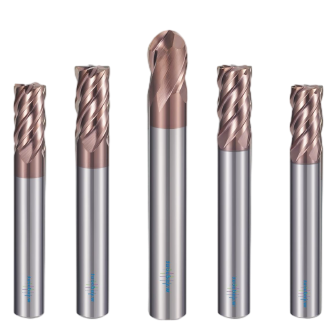Índice
AlternarCNC End Mills for Aluminum
When it comes to CNC machining of aluminum, the choice of end mills plays a critical role in the success of the process. The right selection can significantly improve efficiency, accuracy, and overall performance. In this comprehensive guide, we will delve into the key factors you should consider while choosing CNC end mills for aluminum, highlighting their advantages and application areas. By the end of this article, not only will you be equipped to make an informed decision, but you will also have a better understanding of the intricacies involved in selecting the best CNC end mills for aluminum.
1. Material Composition and Coating
One of the essential factors to consider when choosing CNC end mills for aluminum is the material composition. It is crucial to opt for end mills specifically designed for machining aluminum. These end mills are typically made from carbide or high-speed steel (HSS). Carbide end mills are known for their superior strength, durability, and heat resistance, making them highly suitable for aluminum machining.
Additionally, the coating applied to the end mills is essential for enhancing performance. A popular coating for aluminum machining is TiAlN (Titanium Aluminum Nitride). This coating improves the tool’s hardness, durability, and wear resistance, thereby extending its lifespan. Look for CNC end mills with TiAlN coating to optimize your aluminum machining experience.
2. Flute Design and Geometry
The flute design and geometry of an end mill are crucial to ensure efficient chip evacuation and prevent built-up edge during aluminum machining. The number of flutes impacts the chip removal rate, surface finish, and overall productivity.
Typically, end mills designed specifically for aluminum machining have two or three flutes. These flute configurations allow for efficient chip evacuation, reducing the chances of chip recutting and improving surface finish. The reduced number of flutes also prevents excessive heat generation and prolongs tool life.
3. Helix Angle
The helix angle refers to the angle between the flute and the axis of the end mill. It plays a crucial role in chip evacuation, tool strength, and overall performance.
For aluminum machining, a higher helix angle is preferred as it aids in efficient chip evacuation, reduces tool pressure, and prevents built-up edge. Look for end mills with a helix angle between 35 to 45 degrees for optimal performance when machining aluminum.
4. Diameter and Length
The diameter and length of the end mill are essential considerations based on your specific aluminum machining requirements. A larger diameter end mill will remove material quickly, enhancing productivity. On the other hand, a smaller diameter end mill is ideal for achieving intricate details and finer surface finishes.
Regarding length, longer end mills provide increased reach for deep-reach milling operations. However, longer end mills may be less rigid, leading to potential vibrations or deflection. Carefully assess your application needs and select the end mill diameter and length accordingly.
5. Application Areas and Advantages
CNC end mills for aluminum are widely used in various industries, including automotive, aerospace, electronics, and more. The primary advantage of using these end mills is their ability to provide high precision and efficiency when machining aluminum components.
With their superior chip evacuation capabilities, CNC end mills designed for aluminum produce excellent surface finishes and dimensional accuracy. They minimize the chances of tool breakage, built-up edge formation, and excessive heat generation. This makes them ideal for manufacturing aluminum parts such as aircraft components, electronics housings, automotive components, and more.
In conclusion, choosing the best CNC end mills for aluminum involves careful consideration of various factors. Material composition, coating, flute design, helix angle, diameter, and length are all essential aspects to keep in mind. By selecting the right end mills, you can optimize your aluminum machining process, ensuring high precision, efficiency, and overall performance.
Therefore, when searching for CNC end mills for aluminum, pay attention to the specific product features, such as carbide or HSS material, TiAlN coating, and the appropriate flute design and helix angle. By understanding your application requirements and selecting the appropriate end mills, you can achieve outstanding results in your aluminum machining projects.
Remember, the keyword “CNC end mills for aluminum” is crucial for search engine optimization. By incorporating this keyword naturally throughout the article, you increase the chances of your content being crawled and included in search engine results. So, keep these guidelines in mind and make an informed decision when choosing the best CNC end mills for aluminum machining.


